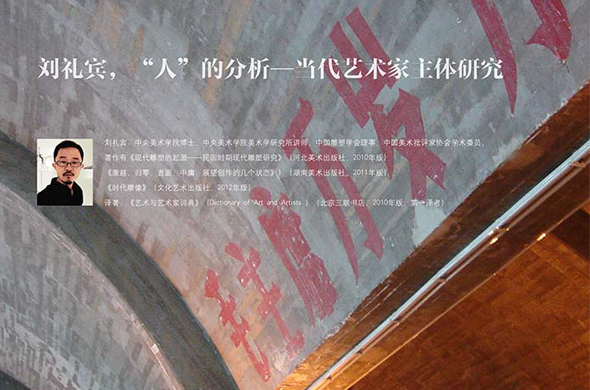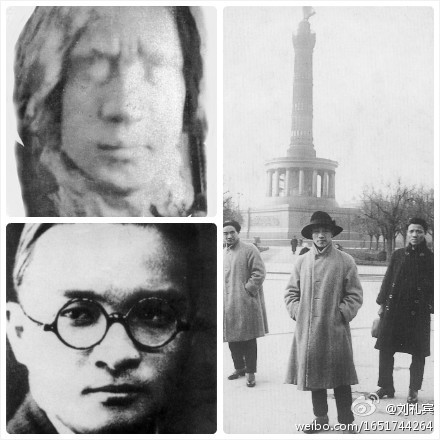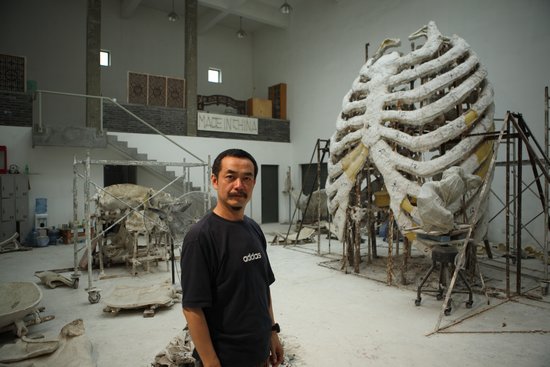
Sponsored by Kongbai Poets Society from CAFA, “The Study of ‘Human’ – Research of the Subject of Contemporary Artists” of the New Youth Art Salon series was held in Room A-103 of building 5, at 18:30, on March 21, 2013. Liu Libin was the speaker of the lecture, and he talked about his thinking and understanding of the “subject of contemporary artists”, by tracing back the changes of the subjects of sculpture and sculptors’ identities from the 20th century, as well as questioning and an analysis of the “subject” of the ancient and modern Chinese artist.
"Variability" with Each Individual– the subject of the performance of Chinese sculptures in the 20th century and the changes of the identity of the “sculptor”
Liu Libin initially brought everyone together to review and trace back the ancient Chinese sculptures, most of the subjects were the statues in the temples, and so on, because the ancient Chinese believed in “the soul residing in the substance”, and different structures of knowledge, there was rare direct performance with humans or installation of the bust. Even the simulations of real people, most were sculptures made into figurines for funerary. Not until the early 20th century when a large number of art students returned from overseas, who performed as celebrities at the time, did sculptures become widespread, and the concepts of sculpture and sculptors started to appear and become popular with the public. Liu showed a series of works, such as Li Jinfa’s “Lin Fengmian”, etc.

In the second stage, the emergence of a large number of monumental sculptures, the subjects of the performance were the celebrities and leaders connected to the political ideology. Liu took Sun Yat-sen for example, he analyzed that the sculptures at the time were not equivalent to the people, but associated to the advocacy policy, since Sun Yat-sen, the state had been closely related to the blood of the nation, therefore, a large number of sculptures of Sun Yat-sen were produced, which were not personal behaviors of remembrance, but the political behaviors associated with the building culture and encouraged the national morale. The relationship between sculpture and people became closer. The third stage was the revolutionary war, when a large number of “symbolic” forms started to emerge, taking “The Monument to the People’s Heroes”, a relief by Hua Tianyou for example, fully embodying the “spiritual resonance”.
In the fourth stage, taking the group sculptures of the “Rent Collection Courtyard” of the 1950s for example, due to the need for completed performances of the denouncing of the working class, and the oppression suffered by them, the extreme realism became widely popular.
In the 1970s, Liu mainly talked about the group sculptures of “Serfs Anger”, of dramatic stage effects, and the shaping of some specific themes, which was similar to the Model Operas. In addition, a large number of Chairman Mao’s portraits were the subject of the performance of the Cultural Revolution. After the reforming and opening up, and entering the contemporary period, Wang Keping’s “Silent” leapt out of the traditional performance of the personal feelings, and could be said to form the contemporary art of the modernism era. In the 1980s, it was a time for “modernist self-assertive” feelings to go public, when the artists carrying idealisms, began to think about themselves, performing their inner pain and anger.
Zhan Wang’s works “Super Realistic Goal is Zero, Abandoning Something that I have learnt” (that is the detailed description of the objective reality)”, the subject of the art transformed into the embarrassing from the resentful publicity. In this case, the works of sculpture didn’t show an attitude, but became an attitude. As Liu Libin said, “If the language of art is not established, then art would be difficult to stand.”
The subject of sculpture was constantly changing, sculptor, as a creative subject, whose identity is also constantly changing. “Sculptor” of the Early Republic had multiple identities, Liu Libin cited three examples: Firstly, Jiang Xiaojian, a “social home” and “sculptor”. Secondly, Li Jinfa, a “poet” and “sculptor”, thirdly, Pan Yuliang, a painter and sculptor. After the founding of PRC, the sculptors were connected to the politic, and couldn’t fully demonstrate their own personalities. In the 1980s, the Chinese sculptor connected with Western artists, and thus the concept of avant-garde was afferent, and the “avant-garde” here had two meanings, one was the alternative space represented by Courbet, another one was the resistance ideology like liberalism. Subsequently, Liu Libin took Sui Jianguo as an example, talking about the creative process of contemporary sculptors. Before 1985, Sui Jianguo was impacted by Zhuangzi’s “Equality of Things”, and “Xiaoyaoyou/ Happy and Boundless Excursion”, advocating the “use of an object to create object”, in the late 1980s, self-consciousness, in the 1990s, based on the state of self-creation, he had an in-depth excavation of self artistic creation. From 1997 to 2005, the creations of Sui Jianguo were filled with social intrusive questioning and criticism, but art had a full performance when the word couldn’t convey the proper meaning, by means of physical power. After 2006, his creations stayed away from the superficial ideology, flowing into the sea of subconscious, waking up as a physical memory. Here, Liu Libin teacher concludes, artists should own areas, excavation owns limits, to take full advantage of the limitation of creation.

Sui Jianguo at his Studio
Talking about “Learning Both Sound in Theory and Practice” again
Liu Libin talked about how he recently reflected on the foothold of the Chinese contemporary art, i.e. reflection and questioning, and the intervention of reality.
He expected to reflect on the logical basis of the Chinese contemporary art of 30 years, and was reminded of the present value of the transcendence of art, studying the critique of “objects” of the works.
He cited the allusions “Chao Fu didn’t let his cow to drink at the place where Xu You washed his ears”, as well as Zhuangzi’s thoughts and speeches, to elaborate “Inside Saint and Outside Emperor”,
Xu You was a hermit, but still disintegrated problem by rejection, when facing a problem, acting as if he was morally better than other people. Zhuanzi thought that Xu was not as good as Yao, who could not only accept the world, but also let him be on the throne with the elite, it was said that a grand hermit in the city while a small hermit in the mountain, to handle the implicit and brilliant, to cultivate one’s morality was “inside saint” and “outside emperor”, to cultivate self, family, country and even the world. In the 20th century, the trend of the times changed, different from the ancient time, reading and self-cultivation had already not changed the country and politics, which was the problem faced by the Neo-Confucianism. In the 20th century, the subject of Chinese artists also appeared in several different types: Traditional school represented by Huang Binhong, Realism school represented by Xu Beihong, Self-pursuit school represented by Lin Fengmian, and Targeted school represented by Pan Gongkai,
History was still going on, as did the subject of evolution and questioning, and so far there was no answer. Liu Libin said his thinking would carry on, and would be shared with everyone.
Journalist: Sun Zheng, Translation: Chen Peihua/CAFA ART INFO




























